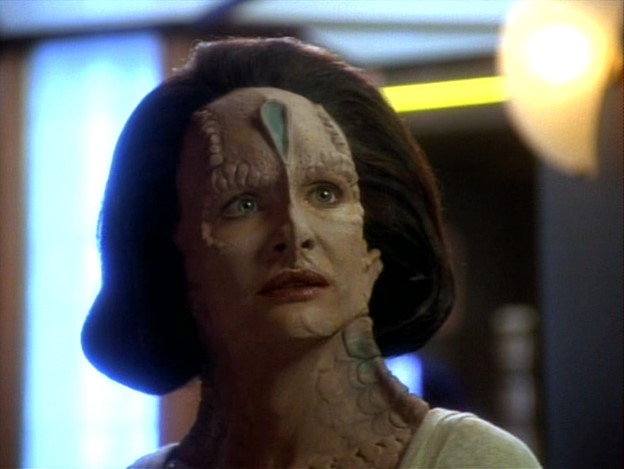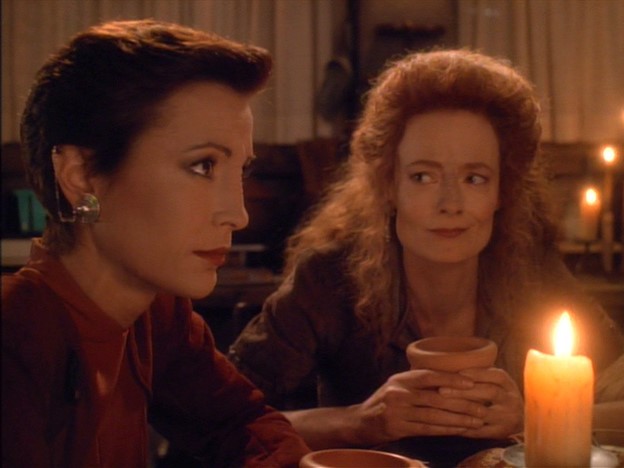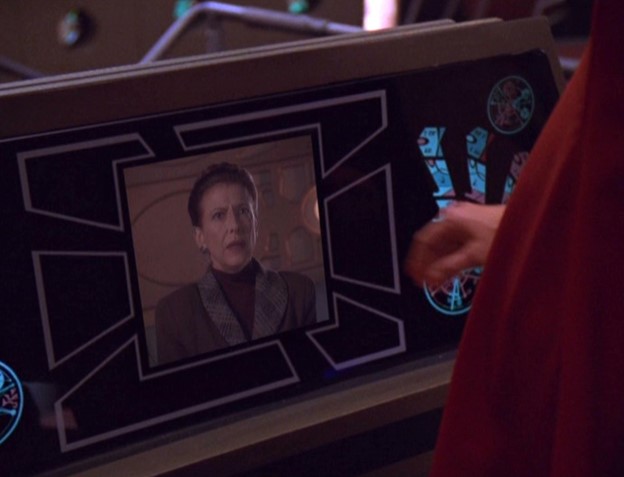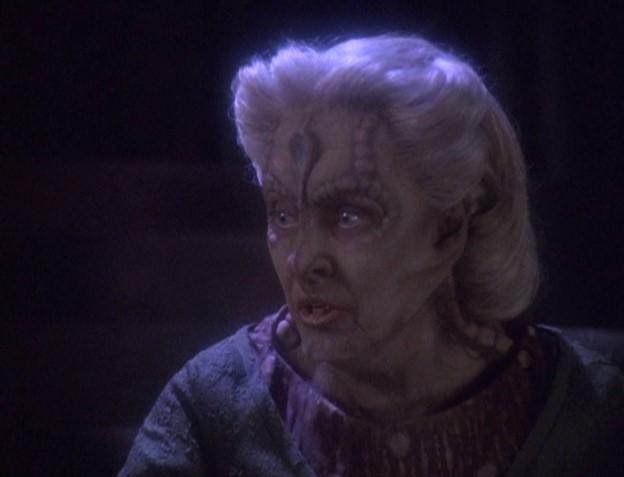Among the reasons I love Deep Space Nine is that it engages so deeply with what resistance to unjust power and authority really means. Over its seven seasons, we get to know Bajoran, Maquis, and Cardassian resistance movements in detail.
And women are involved in every level of these movements, from armed fighters to intellectual dissidents and so much more.
With abortion becoming illegal in many states around the United States, as LGBTQIA+ rights are increasingly under attack, and while climate change continues unabated, we have a lot to resist on Earth today. I am glad to highlight these powerful revolutionaries, each working in her own way, at a time when there is important work for all of us to do!
Natima Lang

When we meet Natima Lang (“Profit and Loss”), she is a professor fleeing Cardassia with her students. They lie to the station personnel, claiming that they were caught in a meteor storm to explain the damage to their ship. (This lie doesn’t last long under O’Brien’s scrutiny, but given how Garak tries to give up the dissidents to the Cardassian government, it was obviously a necessary precaution.
We learn that Natima previously worked on Deep Space Nine as part of the Cardassian government during the Occupation, but she mentions to Quark that she admired how he helped get food to the Bajorans, so she must have at least been sympathetic to their cause, although we don’t really get to hear if she was much of a resister at the time.
But now, Natima displays strong loyalty and protectiveness of her students, and a dedication to transforming Cardassian society through sharing dissenting ideas. In a stereotypically Cardassian way, Natima frames her resistance to the current Cardassian government as ultimately being her duty to the state.
Her romance with Quark is an interesting foil too – and I think it goes to show that dedication to the resistance often comes at some personal sacrifice or cost. While she’s tempted to reunite with Quark and set aside some part of her resistance, ultimately she chooses to stay on the run, and to protect Quark by keeping him at length from her.
Lupaza

We first meet Lupaza when Kira goes to Dahkur Province, trying to get soil reclamators returned as a favor to the Kai (“Shakaar”). Lupaza is a boisterous, warm, and fierce woman, somewhat older than Kira.
I feel so at home with her character. She exudes a lot of love and enthusiasm, and fierce defense of her people, whether that’s Bajorans as a whole during the Occupation, or the Dahkur Province farmers who need the soil reclamators to make their land arable again.
Lupaza seems almost eager to take up the resistance life again when they choose to flee Kai Winn’s police. She’s at home in the struggle. It’s something that Kira and Lupaza share, as Kira also easily abandons her station duties to protect her friends.
We only learn more about Kira’s deep connection to Lupaza after she’s murdered by a secretive killer with a vendetta against the Shakaar resistance (“The Darkness and the Light”). Kira is lying on a bed in the backroom of sickbay, holding her earring fondly (an earring made by Lupaza to celebrate Kira’s first fight), as she tells Odo a story. Lupaza got Nerys started in the Shakaar resistance cell, sticking up for her when she wanted to fight with the others at age thirteen. “She said I had the heart of a sinoraptor,” Kira remembers.
I am so impressed by those who can easily find joy and energy amongst the struggle, and Lupaza is one of those people. Paulo Freire says in Pedagogy of the Oppressed: “Because love is an act of courage, not of fear, love is commitment to others. No matter where the oppressed are found, the act of love is commitment to their cause – the cause of liberation.”
Trentin Fala

Trentin Fala is a very small side character in “The Darkness and the Light,” but one who caught my attention anew on what must have been my fourth rewatch of this episode.
Kira tells us that Fala was never a member of the Shakaar resistance cell because she cleaned floors in a Cardassian records office. (Was this office connected with the office that Natima Lang worked in on Deep Space Nine? Somebody should write this fic if it doesn’t exist already.) Fala would pass information to the resistance, valuable information that helped them plan their attacks.
Kira notes that Fala was always very afraid of being found out by her captors and punished, or even later, being killed or hunted down. “I told her once that I thought she was braver than all of us because she had to live with her fear every day.”
The Shakaar resistance could flee into the hills and could take respite. They could experience some freedom from their struggle, however limited. Trentin Fala could not. And still, every day, she made the same choice to continue to do the work she was forced to do, but also support the resistance movement that she hoped one day would free her and other Bajorans.
It’s a strong reminder that being effective in resistance, and even having courage to act, does not require a lack of fear. We can act in spite of fear.
Mila

Mila is not quite as steeped in the resistance movements as the other characters I’ve highlighted. As the housekeeper of Enabran Tain, the head of the Obsidian Order, she is, in fact, quite connected with an oppressive force. Long after Garak’s exile, Mila continues to live with Tain, and she lives in his house after he dies.
However, when all is said and done, she provides shelter to Garak, Kira, and Damar, revolutionaries on the run from the law (“Dogs of War”). She endangers and ultimately loses her own life trying to keep them safe.
Of course, she has a special connection with Garak – she wouldn’t have hid just any revolutionaries in her basement. Like Fala, Mila stays in the background and away from political or public engagement, but is willing to take additional risks when she can, to defend someone she’s close to.
When such close contacts are trustworthy, they can make the difference.
So many icons of resistance
Kira has always been my revolutionary icon in Star Trek, but there are so many powerful resisters in the Star Trek universe. Each of these women has drawn on their strengths and their positions in the world to make a difference where they can.
We can take strength and ideas from their examples even as our own modern-day struggles might look quite different. And like them, we can keep on fighting.